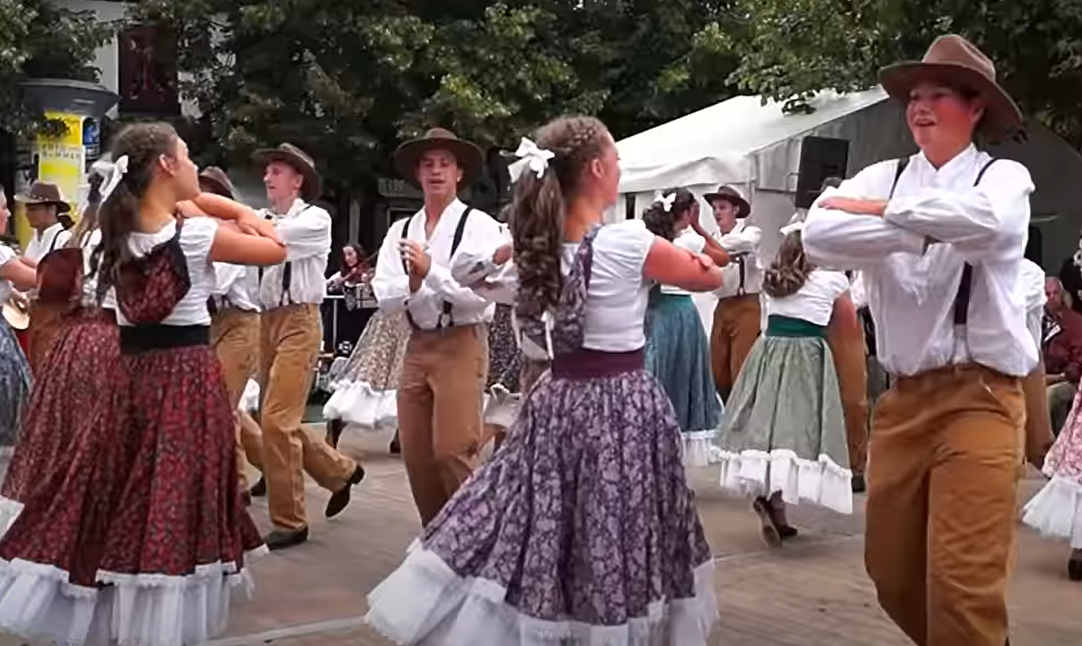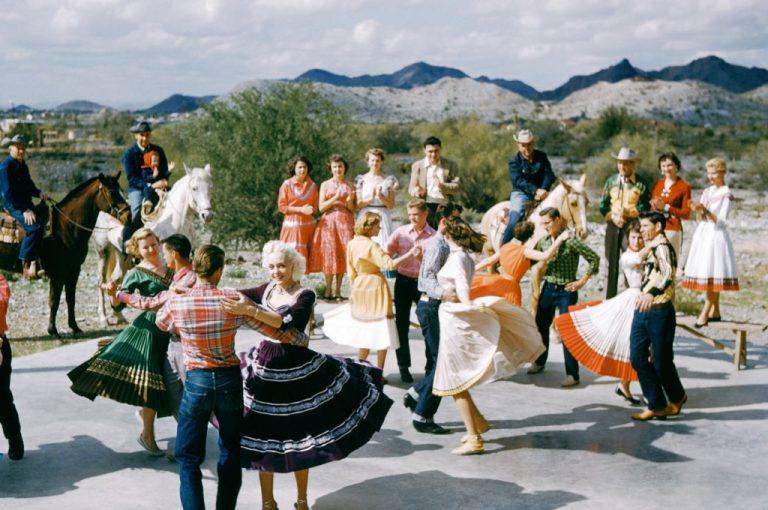“Allemande left and do-si-do!” Does this phrase make you want to dance? Does it recall vague memories from high school gym class? Or is it a mysterious mumble of mishmash? If you don’t know the meaning of these words, you’re missing out on a world of fun.
Square dancing was once recognized as the national folk dance of the entire US, and 31 states still declare it to be their official dance. This lively social activity requires four couples (to form a square), some old-time music (like a jig or a reel) and a caller (to give commands like those mentioned above). Besides being fun and easy-to-learn, square dancing has many benefits for physical and mental health.
The number of square dancers is dwindling, however, as its members tend to be middle-aged and older. It’s actually suitable for all ages, and is a perfectly wholesome family outing. Let’s see if we can inspire some curiosity and interest among the younger generations to keep this American tradition alive and swinging.
How did square dancing start?
Square dancing emerged from a combination of folk dances brought over from Europe; including the French quadrille, the English morris dance, and English country dances.
The quadrille
The quadrille was an elegant dance popular in Paris. It featured four couples performing prescribed, regular movements within the square. This fashionable dance required fine dress and highly refined etiquette. The music was often a medley of opera melodies.
Morris dance
Success
You are now signed up for our newsletter
Success
Check your email to complete sign up
The morris is a lively dance with more intricate stepwork. White hankies, sticks and bells are often part of the attire, purportedly to ward off evil spirits. The male and female dancers have separate groups.
Morris dancing is still alive today thanks to folklorist Cecil Sharp, who set out to record the dances, music, and recollections from surviving members. His work sparked a new interest in the otherwise declining tradition.
John Playford
Many English country dances were recorded in John Playford’s 1651 book, The English Dancing Master. The original volume featured the instruction for 104 dances, along with their music, set to the fiddle. Subsequent versions of the book included hundreds of additional dances. Many of the moves found in this book are featured in North American square dance.
Square dance
Square dancing evolved during the pre-Civil War period, and slaves were often employed as musicians for the dance. While today’s musicians are either paid or volunteers, we owe the unique characteristic of “calling” to African Americans of the time, who began announcing the steps and formations to help organize the dance floor.
Without the pomp of the quadrille, or the bells and sticks of the morris, square dancing became a common social activity that anyone could enjoy. After World War II, Educator Lloyd Shaw integrated the dance into high school physical education programs across the country. Square dancing remained popular throughout the 20th century, and was named the national dance of the US in 1982.
By the 21st century, however, the number of square dancers was on a sharp decline. Many schools dropped it from their curriculums due to lack of interest among the younger generations. Indeed, it’s hard to compete with a hand-held device that captivates you with stimulating media of all sorts, all day long; but let’s see what square dancing has to offer.

Benefits of square dancing
Square dancing is a fun way to keep yourself in good shape without over-exertion, or great expense. Best of all, it is easy to learn!
Square dancing step by step
Most of square dancing is simply walking. You follow the calls which will direct you on the pattern of the dance. There are 12 basic calls in traditional square dancing, most of which are fairly self-explanatory. Those that aren’t are easy to figure out.
Allemande left: Face your corner, loosely grasp left arms, make a 180 degree turn, drop hands and face your partner.
Do si do: Face your partner, cross the arms in front of the chest, walk forward passing right shoulders, then backward passing left shoulders to face your partner again.
Right and left grand: Face your partner, take their right hand and walk through the square, alternating hands with each person until you return to your partner.
Physical fitness
Like any dancing, square dancing is good exercise. It burns calories, helps keep your muscles toned, and gets your heart pumping. Regular square dancing can improve your blood pressure and cholesterol profile.
Square dancing promotes good posture and can also help prevent osteoporosis by strengthening the weight-bearing bones to slow the loss of bone mass.
The low-impact activity, balance, coordination and flexibility required for square dancing make it an ideal option for those rehabilitating from an injury.
Mental wellness
Square dance’s unique feature of calling requires the dancer to stay alert and listen carefully. This sharpens the mind for good mind-body coordination. The various steps also require cross-lateral movement, which requires both sides of the brain — improving memory and coordination.
Square dancing also relieves stress. The activity releases tension and improves the ability to relax and get good sleep.
Social benefits
Square dancing is a great way to spend time with your partner and other friends. It also provides a relaxed social atmosphere conducive to meeting people and forming lasting relationships. The characters encountered at a square dance may or may not be a cut above those found at a bar, but they are likely to be more clear-headed.
Square dancing can be done indoors or out, but either way, it is a safe, open environment. Whole families can come, with the children forming their own squares. Everyone comes for the fun of it, and it’s not competitive unless you want it to be.
Preserves tradition
At a time when everything is becoming digitalized and impersonal, square dancing helps us reconnect with humanity. Interacting with real people may turn out to be very important for the survival of the human race. Social activities like square dancing also require us to present our best selves, by exhibiting considerate, respectful, and modest behavior.
Traditional square dancing music is lively and joyful, with no hint of vulgar lyrics, morbid tones or jarring discord often found in modern music. Plus, it is often performed live, promoting preservation of the arts.
As a rewarding pastime of our not-so-distant ancestors, there are few better ways to preserve American heritage than taking a “promenade” on the dance floor with your partner.
















